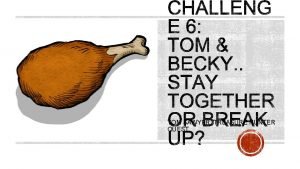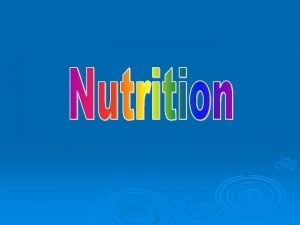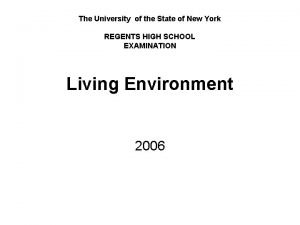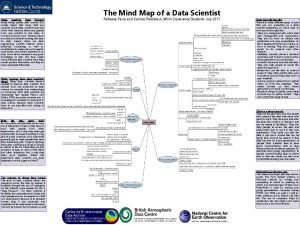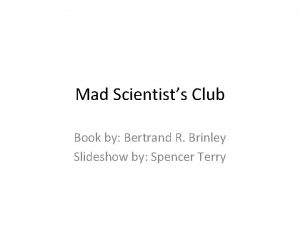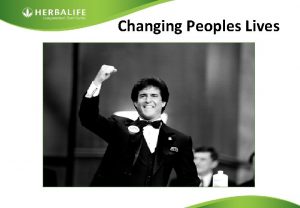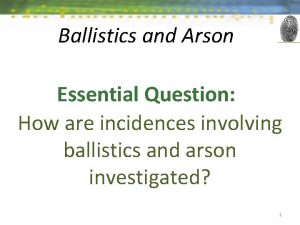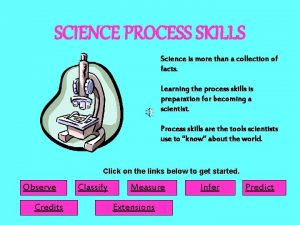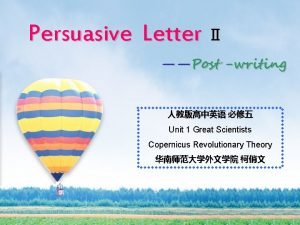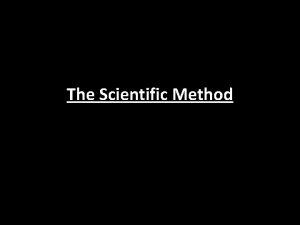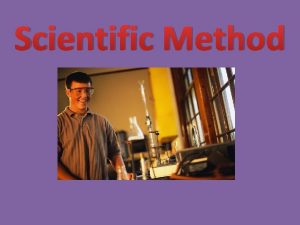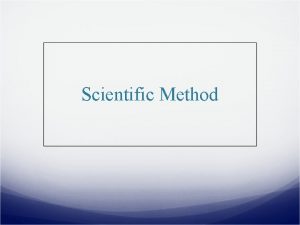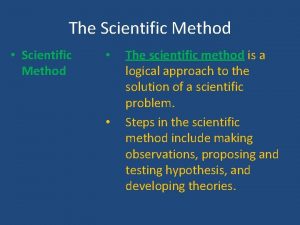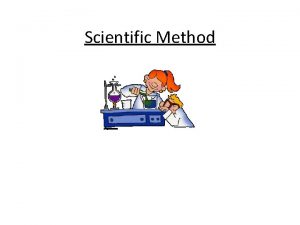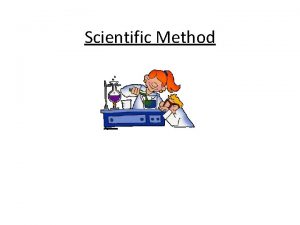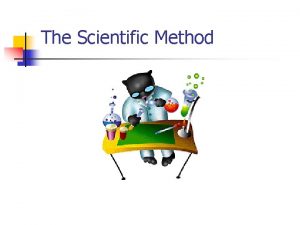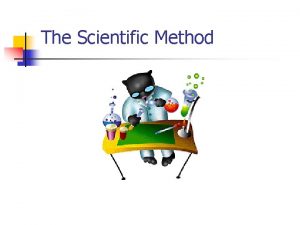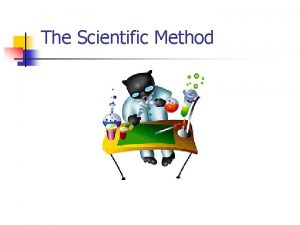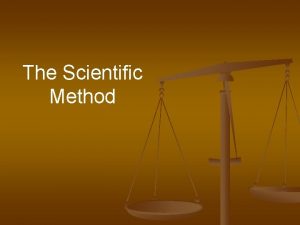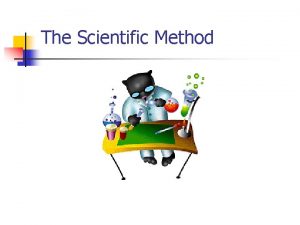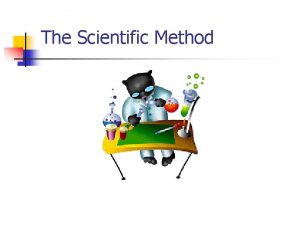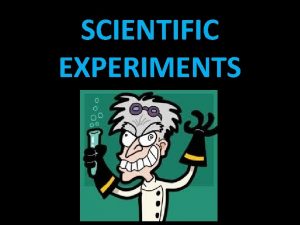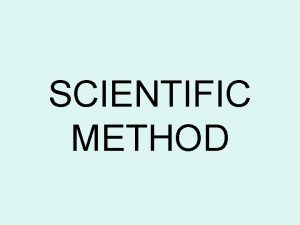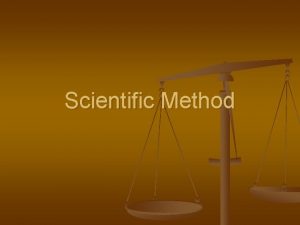Scientific Method Mr Hunter What does a scientist































- Slides: 31

Scientific Method Mr. Hunter

What does a scientist look like? Draw a picture of what you think a scientist looks like.

www. eepybird. com Do you think this represents a true scientific experiment? Why or why not?

Where do I begin? The first step is to decide on a topic that interests you.

Question Develop an investigative question.

You decide… Which of these are suitable questions for a science fair project? n n n 1. What does a human heart look like? 2. Does the life of a light bulb depend on its wattage? 3. What are three types of volcanoes? Where are they found? 4. What are the effects of caffeine on the respiratory rate of cockroaches? 5. How does wing shape affect the lift of planes? 6. What kinds of clouds appear in the sky every day?

Decide whether or not each question is good for experimentation. Copy only the questions that make a good experiment. 1. What does a cell look like? n 2. Which type of battery lasts the longest? n 3. Will mentos or sweet tarts cause diet coke to shoot higher? n 4. What is the function of the liver? n 5. Which has more sugar- Eclipse or Trident gum? n

Hypothesis An hypothesis is written in the form of an if-then sentence. Example: If amaryllis plants are given more sunlight, then they will grow more.

Write an hypothesis for each of the following questions. n n n 1. Will eating sugar before a test improve performance? 2. How does acid rain affect plant growth? 3. Does playing music help plants to grow? 4. Does soil particle size affect plant growth? 5. Which type of soap works more effectively to kill bacteria?

Decide on Variables n n n Independent Variable: the variable that the scientist changes in the experiment Dependent Variable: the variable that changes in response to the independent variable Control: the part of the experiment that does not change

Decide on the variables/controls. n n 1. Will different colors of light affect a gerbil’s ability to go through a maze? 2. What is the optimum temperature for yeast to ferment? 3. Will different temperatures affect golf ball performance? 4. At what age do fruitflies best mate?

Choose the topics appropriate for scientific study and write a hypothesis, variables, and control for each. n n n 1. What are the effects of different voltages of electric currents on germinating seeds? 2. What are the functions of the Environmental Protection Agency? 3. What is the relationship between test performance and being left-handed or right-handed? 4. Why can you see the moon during the day? 5. What happens during solar and lunar eclipses?

Writing a Procedure n 1. The procedure should be _______ and written well enough so that someone else could perform the experiment.

Procedure n n 2. Include units of amounts. 3. The first word of almost every step should be a verb.

n 1. Pour one packet of activated dry yeast into each Ziploc bag. 2. Add 1 teaspoon of sugar to one of the bags and label the bag 1 tsp. 3. Add ½ teaspoon of sugar to another bag and label it as ½ tsp. 4. Add ¼ teaspoon of sugar to the fourth bag and label it as ¼ tsp. 5. Mark 0 on the outside of the last bag and do not add any sugar to it 6. Pour warm water into the large bowl so it is about 2/3 full. Check the temperature of the water with thermometer. The water should be about 46 o. C (115 o. F). Add hot or cold water to bring the water to this temperature.

n 7. Use the measuring cup to dip ¼ cup of warm water from the bowl into each of the bags. Gently squeeze each bag between your fingers to mix the contents thoroughly. Make sure that there are no dry pockets of yeast or sugar in the bags. 8. Squeeze most of the air out of the bags and seal them. Set the bags in the bowl of warm water in a warm place so it will not cool down rapidly. 9. Wait 30 - 40 minutes. 10. Take the bag marked 0 out of the water, dry it, and place it on a flat table. Put the cardboard or notebook on top of the bag, holding the tablet level. Use the ruler to measure the distance from the table to the bottom of the cardboard. 11. Record your measurements. 12. Repeat #10 with the remaining bags. 13. Calculate the approximate volume of carbon dioxide in each bag: measure the length of the bag (a); measure the width of the bag (b); distance from table to cardboard (c). a x b x c will give you the

Write these directions like they should be written for a scientific procedure. 1. Add peanut butter to bread. n 2. Add jelly to bread. n 3. The breads should then go together. n 4. You have a sandwich n

Clothespin Experiment Which thumb muscle is the strongest?

Hypothesis : If we open/close a clothespin in both hands, then the _____ will be able to open/close it more times since it is the strongest muscle. Independent Variable: the hand Dependent Variable: the strength of the muscle

Control n A control is something that stays the _____ throughout the experiment.

Procedure 1. Open and close clothespin in right hand for one minute. Count and the number of times you open and close it. Record data Complete two additional trials. 2. Repeat step 1 for left hand.

Data n Data is information in numerical form usually displayed as a _____, table, or _____.


Data Trial 1 2 3 Right Hand (# of Left Hand (# of times)

Drawing Conclusions n You must _____ data to determine if your results supported your hypothesis.

If your results do not support your hypothesis, then you must make a new one or carry out further observations or experiments.

How can we represent this information in a graph?

Year 1880 Atmospheric Carbon Dioxide (ppm) 260 1900 290 1920 300 1940 318 1960 340 1980 360 200 700

Create a line graph using the data on atmospheric carbon dioxide. n n 1. Has the amount of carbon dioxide in the atmosphere increased or decreased since 1880? 2. The line on the graph is curved. What does this curve indicate? 3. Was the rate of change in the level of carbon dioxide between 1940 and 1960 higher or lower than it was between 1860 and 1900? How can you tell? 4. What conclusions can you draw from this data?


Glad Weight Held (lbs. ) Trial 1 Trial 2 Trial 3 20 30 28 Great Value 70 89 96 Hefty 30 50 40
 Joe hunter treasure hunter
Joe hunter treasure hunter Scientific inquiry vs scientific method
Scientific inquiry vs scientific method Hunter method plumbing
Hunter method plumbing How does the scientific method work
How does the scientific method work How is a scientific law different from a scientific theory?
How is a scientific law different from a scientific theory? Techniques of symposium
Techniques of symposium Food scientist measure food energy in
Food scientist measure food energy in Data science ausbildung wien
Data science ausbildung wien Things a computer scientist rarely talks about
Things a computer scientist rarely talks about The diagram below shows how a coverslip should be lowered
The diagram below shows how a coverslip should be lowered Data science mind map
Data science mind map Far side rocket scientist
Far side rocket scientist Nih staff scientist
Nih staff scientist Si derived unit of pressure scientist
Si derived unit of pressure scientist Mad scientist club book
Mad scientist club book Penjual sebagai artis dan scientist
Penjual sebagai artis dan scientist What does forensic mean in latin
What does forensic mean in latin What makes a scientist
What makes a scientist Chartered scientist
Chartered scientist Founder of herbalife nutrition
Founder of herbalife nutrition Burned fire scientist questions arson
Burned fire scientist questions arson Avogadro scientist
Avogadro scientist Professional natural scientist
Professional natural scientist Chief scientist office scotland
Chief scientist office scotland Sam fraiberger
Sam fraiberger Forensic science jobs
Forensic science jobs Famous english scientists
Famous english scientists Quantum mechanical model scientist
Quantum mechanical model scientist Think like a citizen scientist journey daisy
Think like a citizen scientist journey daisy Science process skills predicting
Science process skills predicting Paragraph on scientist
Paragraph on scientist Jelena dzakula
Jelena dzakula
